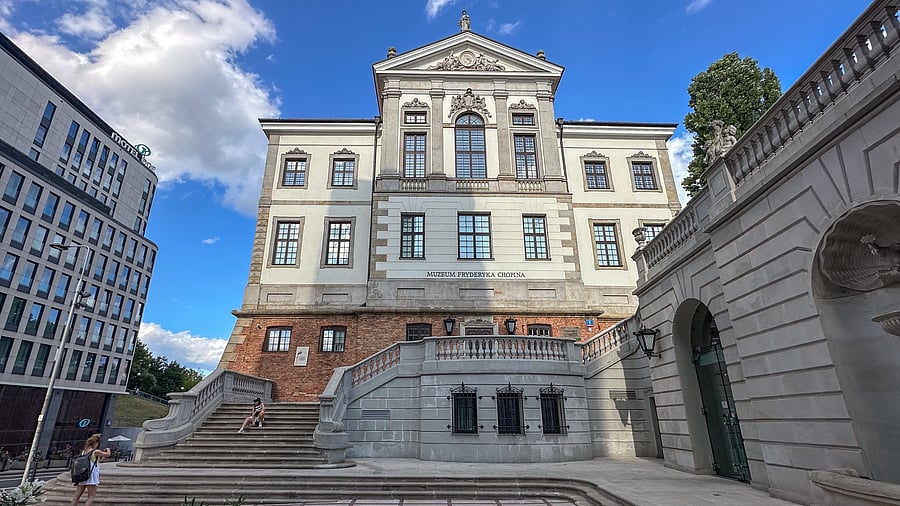
Museum of Fryderyk Chopin.
Photo by Author
From the minute I set foot in Warsaw, I could feel the presence of the city’s famous son and virtuoso composer, Fryderyk Chopin. The Warsaw Chopin Airport is named after Fryderyk, who was educated and composed several of his musical masterpieces in this city. It seems fitting, on a quest of all things Chopin, for me to head promptly to the Royal Lazienki Park.
This lush park with its winter garden, amphitheatre and the summer residence of the last Polish King — Stanislaw August Poniatowski, is seductive in its offerings. I postpone a visit to the monumental galleries and the fine interiors of the Palace because the clock strikes four. Time for the weekly Sunday summer concert of Chopin’s music, which takes place (at noon and 4 pm) between May and September, around the iconic Chopin monument. Relaxing on the grass, amid occasional peacocks and very friendly squirrels, are travellers and locals, united by the music of Chopin, played by Polish and overseas pianists. If you’re visiting at another time of year, fret not, for a few pixie steps away from the monument, is a Chopin multimedia bench. Press a button and listen to Chopin’s music streaming from it. These benches are strewn around the city, at sites connected to the musical genius.
A six-minute taxi ride from the park, the very contemporary and interactive Fryderyk Chopin Museum is located in the Baroque Ostrogski Palace. Carefully curated objects like his last piano, handwritten musical score, and personal notebooks—all rich with biographical detail—take me meaningfully through Chopin's life. Listening booths in the basement allow for a deeper understanding of Chopin’s emotionally sensitive and technically brilliant compositions.
Even for one on a dedicated Chopin trail, you can’t be in Warsaw and not wander along the Royal Route in the direction of the Old Town. This historic centre, now a UNESCO World Heritage Site, came through a remarkably detailed, near-total post-war reconstruction, from the time of its founding in the 13th century. The Royal Route, the city’s most famous route, connects three former residences of Polish rulers — The Royal Castle, Lazienki Krolewskie and Wilanow Palace. I pop into the Royal Castle, the opulent old seat of Polish rulers, that now houses an art collection with paintings by Rembrandt and Bernardo Bellotto, also known as Canaletto. These paintings provided invaluable help in restoring the city after the war.
Everywhere along the Royal route are resplendent churches and monuments of all permutation, worth either pausing at or popping into. For example, in the Baroque Church of the Holy Cross, lies the urn containing the heart of Chopin, a revered relic. It is buried in the left pillar on the main nave of the church, brought to the city from France by the composer’s beloved sister.
Finally, at the Old Town, I am impressed by an atmosphere of warm conviviality, born of colourful townhouses, street artists, stand-alone stores and cafés. I stop at the central square to admire the feisty Mermaid, the official symbol of the city. My last stop in Warsaw is atop the monumental Palace of Culture and Sciences, the second tallest building in both Warsaw and Poland (which itself can be seen from every corner of the city, and is home to cinemas, libraries, museums and theatres).
From the sightseeing terrace on the 30th floor of the Palace, with its Gothic interiors and gallery, I’m able to survey all that made these few days in Warsaw meaningful. The wonder of a sunset boat ride along the Vistula, the longest river in Poland. The experience of the deservedly award-winning Polin Museum, tells the story of the Jews that once inhabited the city. And in the distance, the marvellously quirky Neon Museum, with its iconic and renovated street neon signs collected post their heyday in the communist era, which wow me with their eye-catching design,
inscriptions and fascinating stories.
Warsaw is a city driven by innovation. Buildings like Zlota 44, designed by acclaimed architect Daniel Libeskind and the resplendent 1-hectare garden that sprawls out over the roof of the University of Warsaw Library are testament to this fact. In keeping with this ever-evolving energy, Warsaw also proclaims a fun, festive calendar. For instance, the city hosts the annual international music festival “Chopin and His Europe” and the international Chopin Piano Competition. If Chopin could see Warsaw now, a city driven by intensity, perhaps he’d be beaming.